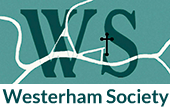In the autumn of 1905 Australian born Muriel Lilah Matters came to England to further her acting career and, as a suffragist, increase her involvement with the international Women’s Freedom League (WFL) at the height of the militant struggle in the United Kingdom.
Women of Substance - Westerham’s association with suffrage, the W.I. and the women’s movement.
Bill Curtis
A strong-minded campaigner for Women’s Rights, through the summer of 1908, Matters took her place as ‘Organiser in Charge’ of the first ‘Votes for Women’ caravan that toured the south east counties of England. The caravan tour began in Oxshott and passed through Surrey, Sussex and Kent.
The purpose of the tour was to speak about women’s enfranchisement and establish new Women’s Freedom League (WFL) branches in the region. Despite the occasional heckler, Matters along with fellow suffragettes Charlotte Despard and Amy Hicks was successful in achieving those aims and establishing several new branches of the WFL.
Most members of the Women’s Freedom League were pacifists, so when the First World War was declared in 1914 they refused to become involved in the British Army’s recruitment campaign. On 3rd July 1914 a non-militant Women’s Suffrage meeting was held on the Green in Westerham where an address was given by Muriel Matters representing the WFL. The meeting was presided over by Granville Streatfeild, whose wife, Lucy Deane Streatfeild had led the women of Kent as one of the organisers of the women's suffrage pilgrimage from the Westerham area to join the Union rally attended by 50,000 people in Hyde Park on July 26 1913.
This is the only political meeting poster to have come to light so far (Jan 2018). Though no year is given, it will date from before 1914 as the Public Hall was requisitioned by the war office at that time as a Drill Hall for the cadets of the Royal West Kents. It was still hired out for community entertainment and events, but political gatherings of any sort were no longer allowed. The speaker at this meeting was Sevenoaks M.P. Henry William Forster whose family were powerful landowners and farmers in Catford and Rushey Green in South London.
This poster appears to publicise an open meeting, there being no reference to exclusion of women, so the most likely date is 1911-12, following the formation of the Conservative and Unionist Women's Franchise Association in 1910. This was a women's suffrage organisation open to members of the Conservative and Unionist Party.
The other important artefact to have surfaced is this ticket to the Summer Fete of ‘Chevening Habitation’ which was the locally registered seat of the ‘Primrose League’.
Led by Sir Henry Drummond Wolff and Lord Randolph Churchill, a small group of Conservative peers had for some time discussed the means for obtaining the support of people from all classes for Conservative principles. Out of their discussions, the Primrose League was founded in 1883, using as its symbol the favourite flower of Benjamin Disraeli. Ladies were generally included in the first organisation of the League, but subsequently a separate Ladies Branch and Grand Council were formed by Lady Borthwick, Lady Randolph Churchill and others in 1885. The Primrose League was the first political organisation to give women the same status and responsibilities as men. Part of the attraction of the League was due to its cross-class appeal - workers could enjoy the summer fêtes at the local ‘Habitation’, the middle-classes could enjoy meeting the local big-wigs, while for upper-class women, the League offered an opportunity for political mobilisation, with the new safety bicycles providing the means for them to independently reach Sevenoaks and the outlying villages.
Lucy Deane Streatfeild was an active supporter of the women’s suffrage movement and lectured for the National Union of Women’s Suffrage Societies. During the years 1914 - 18 she was appointed an Executive Committee member of the Women’s Land Army in Kent, with special arbitration powers to settle disputes over wages and conditions of employment of munitions workers and their dependents. At the end of the war she was appointed Chairman of a committee of enquiry into the conduct of members of the Women’s Army Auxiliary Corps in France, and was awarded a CBE for her work. In 1920 she became one of the first female Justices of the Peace, serving on the Sevenoaks Bench.
With Government support through the Food Production Department of the Board of Agriculture, a tenuous allegiance had been formed during the first World War, between the Women’s Land Army and the W.I., who were cautious to retain autonomy and not become allied to either political or military strings… bearing in mind the fact that the W.I. movement would always declare itself ‘apolitical’ at a time when women did not yet have the right to vote, it is interesting to note that it was to be this promoter of suffrage who would be the prime-mover behind the formation of the town’s W.I.







No Comments
Add a comment about this page